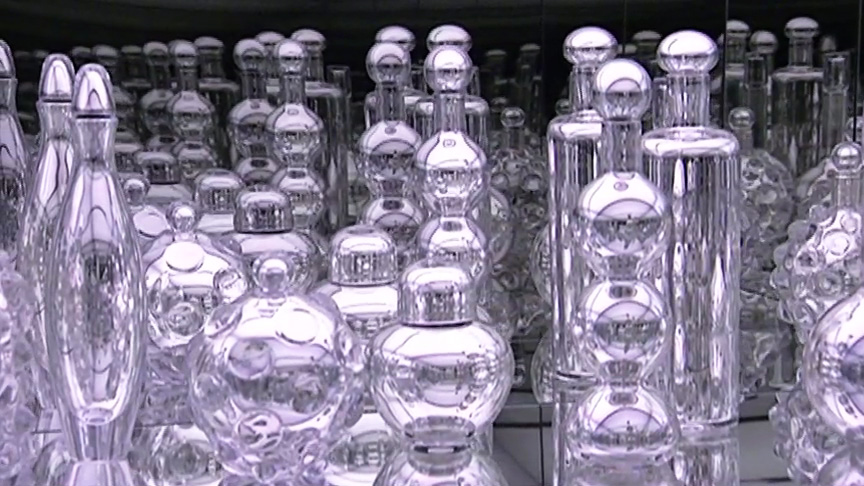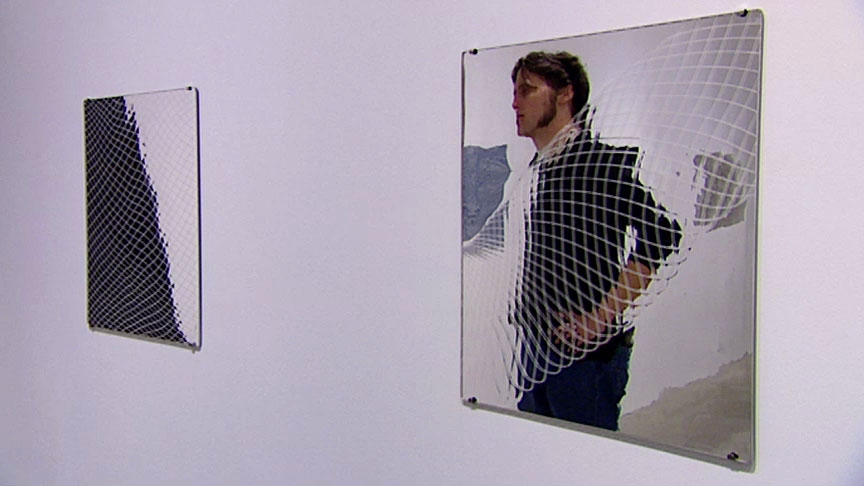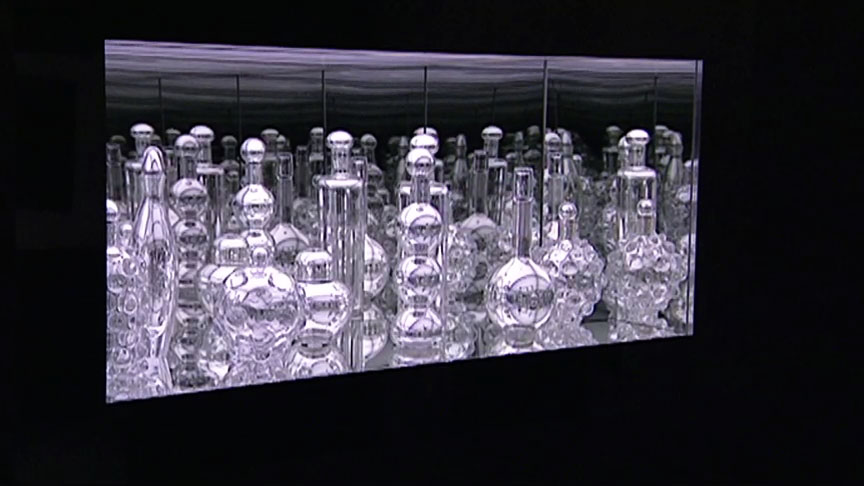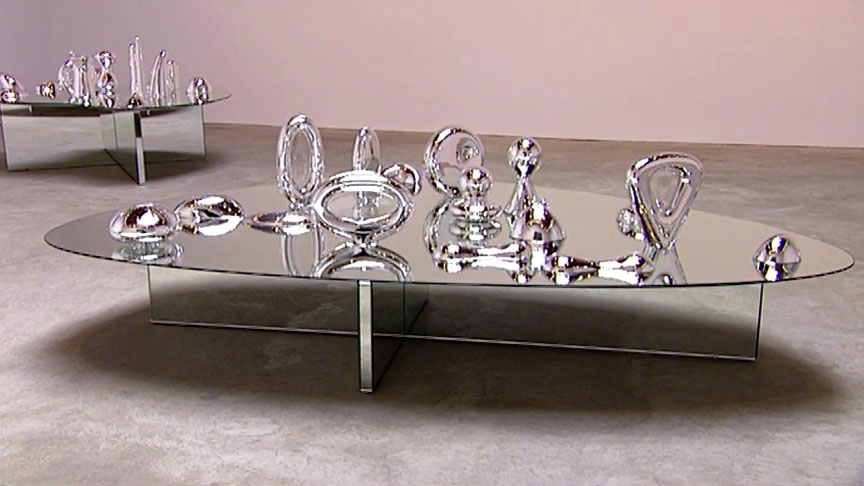Interview
“Total Reflective Abstraction”

Josiah McElheny. Modernity circa 1952, Mirrored and Reflected Infinitely, 2004. Installation view at Donald Young Gallery, Chicago, IL, 2004. Production still from the Art21 "Art in the Twenty-First Century" Season 3 episode, "Memory," 2005. Photo © Art21, Inc. 2005.
Artist Josiah McElheny talks about the objects in his exhibition Total Reflective Abstraction (2007) at Donald Young Gallery in Chicago.
ART21: What role does beauty play in your work?
MCELHENY: The question of beauty is a very funny one to me because, basically, either beauty is in the eye of the beholder, or there is no beauty at all. If beauty is determined by somebody else, I want nothing to do with it.
Artwork can be about ugliness or things that are disturbing, visually or viscerally. But in order for them to actually have any kind of long-term viability as art, they have to have their own beauty. I think one could argue that, for somebody like Francis Bacon, whose work evokes horror as well as beauty, that there is a great deal of beauty. Beauty is about a kind of sympathy to a set of ideas or relationships.
I’m interested in the question of seduction, the idea of: how do you seduce people to be interested in what you’ve done? Seduction often involves presenting something in a very sumptuous way that attracts people. I think that there’s a question of morality in artwork, in the sense of: if something is to be of value, then it has to have a kind of gravity and importance to it. In the Western world, there’s a very deep suspicion of surfaces, of sumptuousness, because maybe that represents a kind of immorality.
I think that my work does bring up that question—not of beauty, but of morality—in the sense of: if something is created to be specifically attractive, at least in its initial impression to other people, is that bad? Is that immoral? And I’m completely fine with the fact that people might dismiss my artwork and say, “This is too sumptuous.” My only hope, though, is that there’s another level to it, which says the opposite. For instance, the all-reflective work or the all-white work—they suggest at first a very seductive thing, but if you think about it for half a second, they become very awful too. Anything that is very seductive is also awful. I mean, if you go to a Renaissance palace in Europe, it could be the most sumptuous thing, but if you think about who paid for this—who made it, who had access to it—then you realize it represents pure evil, at some level.
The white works that I made were all about that very idea—perfection, utopia, modernity—in the sense of a world without ornamentation, without individuation, without grayness. It’s a beautiful gesture in one sense, except that almost immediately it falls apart and becomes something really horrible—especially when it becomes imposed upon the world. I did this installation that’s a completely white room—incredibly bright—all based on this bar by Adolph Loos from 1908. It was his bar, essentially, remade in white and really beautiful, sumptuous.
The whole notion of making all-reflective work is this utopian nature of a reflective object. It gets you involved in it because you see yourself in it, and then the kind of horror, repellant nature of that at the same time. I think that’s a lot of the subject of my work, this idea of a utopia that falls apart. We all want this utopia; we want this fantasy of a perfect world. And yet any perfect world is the worst place there is to be.

Josiah McElheny. Mirror drawings, 2004. Installation view at Donald Young Gallery, Chicago, IL, 2004. Production still from the Art21 “Art in the Twenty-First Century” Season 3 episode, “Memory,” 2005. Photo © Art21, Inc. 2005.
ART21: Talk a little more about the show of reflective objects in Chicago, at Donald Young Gallery.
MCELHENY: The show that I did there was titled Total Reflective Abstraction. Basically there were three parts to it, three different rooms that each contained a different approach to this notion of total reflective abstraction. One was about Isamu Noguchi and Buckminster Fuller. The other had competing versions of the history of twentieth century design objects. And the third was a series of mirror drawings, which were abstraction turned into a literal mirror.
These three works interacted, in the sense of expressing this notion that abstraction was based on reflectivity. If you sit down and reflect on a philosophical idea, you enter a certain kind of state in your mind. If you look at a reflective object and become involved with looking at it, your mind enters a very similar kind of state. So, looking at a reflective object and reflecting on an idea might be very similar experiences. My idea was that this could become a metaphor for how art worked, because basically it’s looking at an object and reflecting an idea.
One set of work, what I called Mirror Drawings, was essentially a sheet of glass mirror put directly on the wall. Embedded inside the glass are abstract lines, drawing lines. Instead of the lead of a carbon pencil, they’re white, and when people look at them, they don’t know how they’re made and assume that it’s some kind of etching process. But if they had been etched—which implies some kind of altering the surface of the glass—they would not have looked the way they did. And what is key to how they looked are the lines, embedded inside the glass itself. It’s too difficult to explain how it was done, but basically it was something that I figured out from putting together a couple of different kinds of glass manufacturing processes.
I made the glass itself, the piece of glass that became a mirror. And at one point in the process, I made this drawing with another kind of glass, and then sandwiched it in with more glass on top. So, they have a kind of quality where if you walk in the room, they don’t look like anything, they just look white, because they’re reflecting the white of the room. But when you stand in front of them, suddenly you see yourself—but yourself overlaid with this pattern, this abstract drawing. So again, that’s this metaphor of what art is—the experience is a fusion of your experience of yourself and the object.
The reflection’s not perfect: it’s a handmade sheet of glass, so it has some rippling. That also calls attention to the fact that it’s not machine-made. It’s an intentional thing to have created this artwork that both reflects you and shows my intention.

Josiah McElheny. Modernity circa 1952, Mirrored and Reflected Infinitely, 2004. Installation view at Donald Young Gallery, Chicago, IL, 2004. Production still from the Art21 “Art in the Twenty-First Century” Season 3 episode, “Memory,” 2005. Photo © Art21, Inc. 2005.
One of the other rooms is darkened with lit displays of objects, and the displays themselves are completely reflective on the outside and completely reflective on the inside. Across the front is a two-way mirror, and the effect is that the objects on the inside are reflected in the mirror in the back of the case, theoretically infinitely. It’s very confusing as a viewer when you first come upon it, because you yourself are not reflected, because it’s a two-way mirror. Optically they’re in a brightly lit room, and you’re in a dark room. Everybody has seen this kind of infinite effect with mirrors—you can even see it in a dressing room with a three-way mirror—that the objects themselves are totally reflective. They reflect every reflection that’s being reflected within it, and these reflections don’t move. That’s confusing because normally, when you walk across a mirror, everything moves as you walk across it.
So, the reflections move a little bit, but basically all these reflections in the objects stay totally still. So, they have this very airless quality. One is a set of objects made from around 1952 and a set from around 1962—classic mid-century Modernist objects remade as reflective objects. They’re quite close in size, shape, and technique to the original ones. An expert in that era of design objects would recognize them, but everybody can recognize them as a kind of aesthetic. They see it as the original or as knockoffs made now by many factories across the world.
Basically the idea was to say, “Okay, the definition of being a modern person in the twentieth century is to examine yourself.” It’s not to be a forthright person according to what situation you were born into, but it’s to reflect on yourself and be a self-knowledgeable person—that’s what it is to be modern in many ways. This, again, is a very wonderful thing but also kind of horrible. These objects represent that culture, reflecting on themselves in an infinite regression, in a kind infinite narcissism. This is sort of what the twentieth century is.
ART21: Tell the story about Noguchi and Fuller, about their conversation and how it relates to the reflective works.
MCELHENY: In this other section of the show, I made a series of works about a conversation between Noguchi and Buckminster Fuller—an aesthetic proposal from 1929—in which they talked about a kind of sculpture or sculpture abstraction that could exist without any shadow. Buckminster Fuller was a kind of scientist-engineer-inventor who’s most well-known for having “invented” the geodesic dome, and Isamu Noguchi was a Japanese-American sculptor said to be sort of a bridge between the East and the West but also very well-known for his famous paper lamps (which you can still buy).
They met in 1929 at a bar called Romany Marie’s in the West Village, and Noguchi had just returned from apprenticing to Brancusi. And they got into a conversation about the notion of abstract sculpture: could you have a three-dimensional object that had no shadow? They said it would have to be a perfectly reflective sculpture in a perfectly reflective environment—the ultimate aesthetic utopia where the context and object are unified completely. And Fuller convinced Noguchi to go to his studio on Madison and, in a laundry room on the top of the building, paint the whole interior reflective silver and create a chrome-plated sculpture—in this case, a bust of Fuller himself—and place it within this environment.
I was very struck by this story. I thought, “How could I try to realize this idea?” They did this experiment but nothing ever happened about it. So, I very simply tried to realize what they proposed. I took Noguchi’s forms and remade them as reflective objects. I created a reflective environment, mostly based on his furniture designs or proposals he did for abstract landscapes. So, the forms are reflective and their environment, the base on which they live, is reflective. It’s a confusing thing to photograph because, basically, you can never see it—except seeing yourself reflected many thousands of times within all the forms and within the plane of the landscape. Also, it’s funny to look at because you can’t tell where the object starts and where the reflection starts—object and reflection become one.

Josiah McElheny. Landscape Model for Total Reflective Abstraction, 2004. Installation view at Donald Young Gallery, Chicago, IL, 2004. Production still from the Art21 “Art in the Twenty-First Century” Season 3 episode, “Memory,” 2005. Photo © Art21, Inc. 2005.
ART21: Why do you think the incident between Fuller and Noguchi resonated so powerfully for you?
MCELHENY: Well, I think that a lot of these ideas are important—recycled ideas invented at a certain point in history. They didn’t fit within the context of the moment they were invented. Or they have always been there but are constantly being returned to, because they are needed in a different way, according to the needs of the day.
This idea of total reflective abstraction that Noguchi and Fuller invented together in a bar—maybe it was too soon for that to become a central theme. Or maybe it was just not important enough. I don’t know. It seems like it has a huge amount of resonance today. It’s something that we’re talking about right now. Even the subject of privacy is about this same idea. Transparency, reflectivity, connection, seamlessness—all these themes are expressed in many kinds of dialogues today.
I also wanted to say they’re about a kind of utopia—the utopia where everything is connected. Everything is perfect, seamless unity. There is something very beautiful about that. But like I said before, it’s not hard to see how it becomes awful, really quickly. It was important, for me, that these are models. And that’s an interesting way to discuss utopia now.
In 1929, it was possible to propose literal utopia: “This is how we should live; we should create a society that’s structured on these utopian principles, and we will have a better world.” I think it’s really clear that, as soon as you actually try to create utopia or impose utopia, it creates horrible violence. I have this notion of talking about utopia as a model, something that’s never intended to go beyond the model stage. And as an artist, that’s something I can do; I can create a model. I can’t create a society, but I can create a model.



